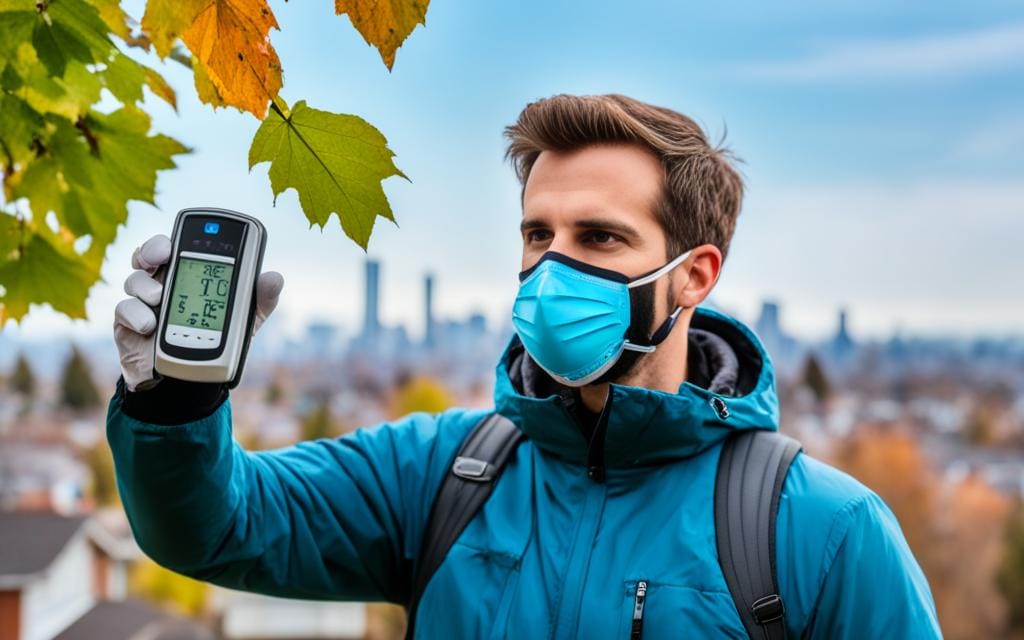In this detailed guide, we’ll look at ways to check air pollution levels at home. We’ll cover everything from affordable DIY kits to citizen science tools and mobile apps. This info will help you check the air quality at home and find ways to make it better.
If you worry about indoor pollutants, particulate matter, or the air quality as a whole, keep reading. By the end of this article, you will know how and have what you need to be a smart citizen scientist.
Table of Contents
ToggleIntroduction to Air Pollution Testing at Home
Indoor air pollution is a big health worry because we’re mostly inside. It’s important to keep track of air quality at home. We do this to find and stop the things that make the air bad like dust, chemicals, and too much carbon dioxide.
Importance of Monitoring Indoor Air Quality
Keeping the air clean indoors is key for our health. Breathing in bad air can cause problems from coughs to serious diseases. Checking the air quality in our homes helps us find and fix pollution sources. This makes our homes a better place to live.
Common Indoor Air Pollutants and Their Sources
Issues like dust, chemicals, and high carbon dioxide often come from inside our homes. Things like cleaning products, furniture, and some building materials can add to the problem. So can air from outside. Knowing where these pollutants come from helps us deal with them. It lets us make our air cleaner and safer.
Low-Cost Air Quality Monitors
Advancements in tech have brought us affordable air quality monitors. Now, we can check the air we breathe at home. These low-cost monitors help us see if our air inside is clean, enabling us to act to make it better.
Particulate Matter Sensors
Particulate matter sensors, or PM sensors, are common in these monitors. They measure tiny particles like PM2.5 and PM10. Too much of these particles can harm our health. These sensors show where these particles come from inside our homes. Then, we can reduce them.
Carbon Dioxide Detectors
Monitoring carbon dioxide (CO2) indoors is important too. High CO2 levels suggest bad ventilation and might mean other pollutants are around. With affordable CO2 detectors, we can check how well our home circulates air. This helps us make our air better.
Volatile Organic Compound (VOC) Sensors
Home air isn’t only affected by PM and CO2. Volatile organic compounds (VOCs) also play a role. VOC sensors find these chemicals from household items. This way, homeowners can lessen the harmful chemicals in the air. This makes our home a healthier place.
These affordable monitors put air quality control in our hands. Using the data from these devices, we can act to improve our indoor air. This empowerment lets individuals contribute to making their living spaces healthier.
DIY Air Testing Kits
There are low-cost air quality monitors and DIY testing kits to use. These kits let you collect and check the air in your home. They help you learn more about the air indoors. This is a cheap way to understand the air you’re breathing.
Advantages of DIY Air Testing
Using DIY air testing kits lets you take part in the process. You collect samples and check the results. This means you see what’s in the air at home. DIY kits are less costly than pro checks, which means more people can use them.
Limitations of DIY Methods
DIY kits are easy and cost less, but they have limits too. The results might not always be super accurate. This is because how you test and understand the data can differ. Plus, collecting and handling samples properly is key for good results.
It’s vital to follow the DIY kit’s instructions closely. You might need to ask experts for help sometimes. Knowing what DIY testing can and can’t do helps you choose the best way to check your home’s air.
Citizen Science and Air Monitoring Networks
We can do more than test our local air quality. Citizen science projects and air monitoring networks help us understand air pollution on a larger scale. They let us share our air quality data and see others’ info too. This way, we all add to a big pool of air quality details. It helps researchers, policymakers, and our community learn about air pollution where we live.
Contributing to Crowdsourced Air Quality Data
More and more people are joining in citizen science air monitoring efforts. It gives us tools to take part in studying air quality. These projects offer simple air pollution sensors for our homes and neighborhoods. When we send our data to these projects, it becomes part of a bigger set. This information can guide actions and decisions about monitoring air pollution in our areas.
This teamwork lets us watch our indoor air and understand regional air pollution better. By putting our results together, we can spot pollution hotspots. We can also see how air quality changes and what affects it in our communities.

Joining in citizen science air projects makes us key players in improving air quality. Even our small efforts can help a lot in figuring out air pollution. We can help find better solutions for this big environmental and health issue we face today.
Interpreting Air Quality Data
Checking air quality is just the beginning. It’s crucial to understand what the numbers mean next. We’ll teach you how to read air quality indices. These indices show how healthy or harmful different levels of pollutants are. You’ll also learn to spot where indoor air pollution is coming from, which helps you make your home’s air better.
Understanding Air Quality Index (AQI)
The Air Quality Index (AQI) turns hard-to-grasp data into a simple scale. By looking at the AQI readings from your monitors, you can see the potential health risks. This includes understanding risks from things like particulates and ozone. We’ll guide you through it, helping you know what to do to keep your family safe.
Identifying Sources of Indoor Pollution
It’s also important to find what’s causing bad air in your home. Studying your air quality data will show you where the pollution comes from. It could be many things, like poor ventilation or chemicals from your furniture. Knowing this will help you fix the real problems, like cleaning up mold or reducing dust.
How to Test Air Pollution at Home
Checking how clean your home’s air is vital for your health. This guide will show you how to test the air quality step by step. We’ll cover picking the right tools and the best ways to measure accurately so you can be a home air quality pro.
Step-by-Step Guide for Home Air Testing
Here’s how to start testing your home’s air quality:
- Find where to test: Choose spots in your home that might be more polluted, like busy areas or places with little ventilation.
- Get the right monitoring tools: Think about what you need and your budget. You can buy devices to check particles in the air, carbon dioxide, or a mix of pollutants.
- Set up your tools correctly: Make sure you follow the setup instructions carefully for accurate results.
- Take air quality readings regularly: Create a schedule to measure the air at the same times and places to watch for changes.
- Understand your results: Learn to read the data and use the Air Quality Index to spot issues and pollution sources.
Best Practices for Accurate Measurements
For reliable home air tests, keep these tips in mind:
- Know your monitoring tools well to correctly read the data.
- Take care of your devices by cleaning them and following maintenance advice.
- Measure the air at the same times and in similar conditions to get consistent results.
- Check your results against local air data to make sure they’re accurate.
- If you’re unsure what your test results mean, get help from experts or online guides.
By following the steps and tips here, you’ll soon be an ace at keeping your home’s air clean. Watch for our next post on how to cut down on indoor air pollution for a healthier home.
Reducing Indoor Air Pollutants
The first step is checking your home’s air quality. Then, it’s time to make it better. We’ll look at how to reduce indoor pollutants. Strategies include better ventilation, air purifiers, and filters. These steps can help make your home healthier.
Ventilation Strategies
Good ventilation is key to cutting indoor pollutants. It changes the air inside with fresh, outdoor air. Opening windows, using exhaust fans, and adding mechanical vents are helpful. They keep your home’s air clean by getting rid of harmful VOCs and other pollutants.
Air Purifiers and Filters
Besides ventilation, using air purifiers helps a lot. Air purifiers with HEPA filters remove dust and pollen very well. They also capture smells and other gas pollutants. Placing them in main rooms makes the air cleaner and safer.
Air Quality Apps and Online Resources
In today’s digital era, we have tons of air quality apps and online tools. They help us check the air around our homes. These resources give us info on pollution outside and how air at home changes. We can use what we learn to choose actions that make our air better to breathe.
Monitoring Outdoor Air Quality
Apps like AirNow and CleanSpace keep us updated on outdoor air quality. They pull data from official sources and show us alerts, forecasts, and past info. This knowledge helps us be ready for bad air days and take steps to guard our health.
Tracking Indoor Air Quality Over Time
For indoors, we can use apps like Air Matters and Plume Labs. They connect to devices that watch the air inside our houses. We can follow things like dust, gases, and CO2. This lets us find out what might be polluting our air and how to fix it.
These air quality tools make it easier for us to keep our living spaces healthy. They work for both the air outside and inside. With this info, we can make smart choices and do things to make our air cleaner. Let’s use technology to look after the air we breathe.
FAQ
What are the common indoor air pollutants and their sources?
Indoor air pollutants like particulate matter, VOCs, and carbon dioxide are common. They mostly come from stuff we use daily. This includes things like our furniture, cleaning products, and outside air.
What types of low-cost air quality monitors are available for home use?
For home use, you can find affordable monitors for particulate matter, carbon dioxide, and VOCs. These gadgets give you important info on your home’s air quality.
What are the advantages and limitations of DIY air testing kits?
DIY air test kits are cheap and let you be hands-on with the testing. But, they might not be super accurate. You need to understand the results properly.
How can I contribute to citizen science air monitoring networks?
You can help by joining citizen science groups and sharing your air quality findings. This info can benefit studies, policies, and your local area’s air quality efforts.
How can I interpret air quality data and identify sources of indoor pollution?
By learning about the Air Quality Index (AQI), you can grasp your air quality readings. This helps you know if the air is safe. You can also pinpoint where the pollution indoors is coming from.
What are the best practices for accurately testing air pollution at home?
To test air pollution well at home, follow a clear guide. Pick the right spots for monitoring and make sure you collect data with care.
How can I reduce indoor air pollutants in my home?
To cut down on indoor pollutants, focus on good ventilation and air cleaning systems. Air purifiers, filters, and fresh air can help a lot.
What air quality apps and online resources are available to help me monitor my home’s air quality?
Many apps and websites are out there for checking air quality both inside and out. They offer updates and tips to keep your home air healthy.









